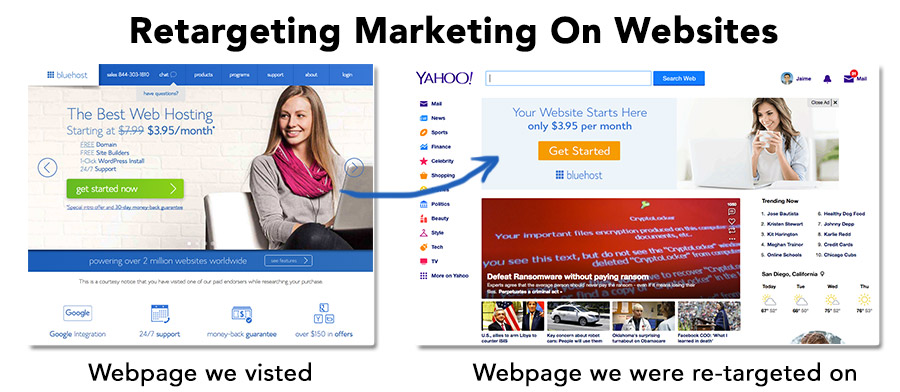5 Tips For Using Retargeting Ads To Boost Sales
Do you remember the first time you saw an online ad for a company shortly after you visited its website? ‘Wow, that’s weird,’ you might have said to yourself ‘Was that a coincidence?’
When it happened again with a different company, you realized that seeing that ad from that company was NOT a coincidence. You begin to question yourself; ‘I don’t know how that company put gremlins into my computer to monitor my website browsing, but it did,’ or ‘I feel like I am being watched. This is spooky.’
The “gremlins” were actually pixels and cookies. Pixels, pieces of a computer programming code, are placed on the browsers of people who visit or visited a website, typically by the company that operates that domain.
Pixels create cookies that spur the creation of specific ads that the website visitors see after they leave the website. The ads --which are called retargeting ads --are based on what products and services the website visitors saw and are designed to get them to return to the website to buy what they earlier looked at.

Figuring out how this is done technically is complicated, but it’s done because of two very simple facts. The first is that “nearly 96 percent of your first-time (website) visitors are not ready to purchase from your website right away,” according to the Entrepreneur magazine article “How Clever Retargeting Persuades Customers Who Looked But Didn’t Buy.”
The second is that people who have seen a company’s website and sales items are more apt to buy than prospective customers who have never expressed interest in the company before and/or are repeatingly seeing their products online.
So how well do retargeting ads work?
In the past few days, Purplepass has reviewed several articles in major publications like Business Insider, Entrepreneur, Forbes, and HubSpot to answer this question. Marketing experts are convinced that retargeting ads are a great investment which is probably why so many companies are doing it. This article lists nine examples of users, including services run by Google, Facebook, and Twitter if you don‘t believe me.

More importantly, some companies have SHOWN that retargeting ads work. Spotix Inc. put a pixel on its website as did 11 brand manufacturers it works with, according to this article in Digital Commerce 360.
The Iowa-based company set up the pixel so website visitors would see a digital ad based on what the visitors saw five to seven times. “The display ads are typically created by brand manufacturers and Spotix puts its logo on top of it,” the article says. The headline and subhead make it clear that retargeting ads have worked for Spotix multiple times. “Ad retargeting helps boost Spotix.com’s e commerce sales 56%.” The subhead says in part that Spotix “achieves a 28-to-1 return on its ad spend with digital display ads and retargeting.”
Can your company benefit from retargeting ads as much as Spotix has?
We at Purplepass don’t know the answer to that question, but we know that your company can maximize the chances it will have if it selects one or more effective ways to use retargeting ads.
Below are five ways you should consider if you want to do retargeting.
1. Form Partnerships:
Spotix had a partnership with 11 of its brand manufacturers, but there is a multitude of other opportunities for using partnerships. Two companies can form a joint venture for a particular project and both sell the project’s product on their website.
This enables Company A to send retargeting ads to people who have visited Company B’s website and vice versa. This strategy not only helps sell the joint venture’s products, but can also spur the visitors to buy other products on the website of the company they did NOT initially visit.
2. Gather Demographic Data:
Many prospective customers could visit your website and the website of a company that collects demographic data. The social media channels Facebook, LinkedIn, Instagram, Twitter and others all collect demographic data.
![]()
Putting a pixel from Facebook Pixel Retargeting on your website will allow Facebook to track the demographics of your website visitors. This could enable you not only to devise more specific retargeting ads, but help you plan a better ad campaign offline with ads on radio, television and in print that are more targeted demographically.
If you wanted to use the Facebook Pixel (basically a snippet of code for your website) check out Instapage as they do a great job on walking you through how to set up your pixel.
3. Launch New Products:
The combination of tracking your website’s visitors and collecting data on them can improve your marketing and product development. The information can help you decide which products to stop selling, which products to market to more people or more specific groups of people, and what products you should sell but aren’t.
So who will buy your new products? Companies often conduct a market survey to find those customers, but you already have been communicating with prospective customers via ads and retargeting.
4. Reach Past Customers:
Pixels and cookies are great for reaching recent visitors to your website, but you can also send retarget ads to past customers who don’t have that gremlin in their computer. You can do this by uploading email addresses you have from past customer interactions to Facebook Custom Audiences.
The retargeting service can then send ads to your contacts. The Forbes magazine article suggests planning an email campaign that includes sending the retargeted ad to contacts who did NOT open your email solicitation.
What is Facebook Custom Audiences?
If you ever promote paid campaigns, track insights and data on Facebook, than you are familiar with Facebook’s Ad Manager.

On this platform you can take advantage of the “Audiences” retargeting service.
By using this service, you are creating a custom audience based off a customer list made up of your existing customers. This will help you target ads to the right audience in your marketplace; usually ones you have created on Facebook, Instagram and other networks.
Once you upload your customer list, Ad Manager will match the people on your list to people with similar attributes on Facebook.
5. Reach Your Readers:
Writing a blog on your website is a fantastic way to show your expertise about your industry and the products you’re selling. People who read your blogs might have never shopped on your website before, but they could be excellent long-term prospects as they know and trust you more. You don’t want to sell them at all at first, but you can eventually send ads to them via Facebook’s “Ads & Boosted Posts.”
“Make sure your ads are relevant to a specific article’s readers,” advises the Social Media Examiner article in “6 Facebook Remarketing Tactics That Work.”






